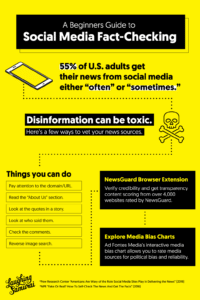
Fact-checking of news sources especially the content from social media and fighting misinformation continue to be a hot topic for the past few years. Stats from the research of the Pew Research Center indicate that 55% of U.S. adults consume their news from social media platforms either sometimes or often. This is quite alarming when a lot of misinformation from unverified news sources are circulated via social media.
It calls the urgency of fact-checking of the news to determine we’re getting accurate information. The following ways include the best practices that people can use when reading articles online, as per the information shared by NPR in 2016.
- Pay attention to the domain and URL
- Read the “About Us” section
- Look at the quotes in a story
- Look at who said them
- Check the comments
- Reverse image search
It will be helpful to know what are the other tools available to ensure we are receiving factual information in addition to doing our self-research.
1) Using NewsGuard to Verify the Credibility of The Social Posts:
You can install any fact-checking tools like NewsGuard, a desktop browser extension tool that can show the credibility and transparency of online content. It will help you ignore websites that circulate unsubstantiated claims. It is reported that NewsGuard rates more than 4,000 websites and review it every three months, the sites that are responsible for approximately 95 percent of all the news and information presented in the United States, United Kingdom, France, Germany, and Italy. NewsGuard is offering its fact-checking service for free to all internet users until July 1, 2020.
2) Understand Political Bias with Media Bias Charts:
You can view Media bias charts created by Ad Fontes Media, a Colorado-based media watchdog organization, that analyzes nearly 600 publications and journalists checking the polarity or inclination to a particular side. This rating system is said to be using humans with subjective biases to rate things that are created by other humans with subject biases.
It will be quite handy to view this simple infographic from the team at Laughing Samurai that can easily provide the six steps you can take to do the fact-checking of the news content that you find online.
Although it may not be sufficient to protect you completely, this can be a good beginning to start the verification of news found in social media. Check out the infographic below.






